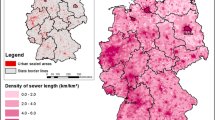Abstract
The GREAT-ER software was used to calculate linear alkylbenzene sulphonate [LAS] and boron concentrations in the Itter stream in North Rhine-Westfalia, Germany. The aim was to investigate the predictive strength of this newly developed tool and to compare its results to measured data. Substance-specific input data which were used in this scenario were partly generic (e.g. LAS and sodium perborate tetrahydrate consumption figures for Germany) and partly (site-)specific data (e.g. half-life time for LAS elimination). The comparison with the measured data reveals that the model predictions for LAS and boron are correct at least within a factor of two, only if generic German consumption data is applied. By using refined input data, the accuracy can be increased further.
Similar content being viewed by others
References
BRW (1997): BRW Jahresbericht (annual report) 1996. Bergisch-Rheinischer Wasserverband, Haan, Germany
BRW (2000): Personal communication. Bergisch-Rheinischer Wasserverband, Haan, Germany
DAGSt (1998): Surfactants statistics 1996. DAGSt, 20.07.98
Dietz F (1975): Die Borkonzentration in Wässern als Indikator für Gewässerbelastung. gwf-Wasser/Abwasser116 (7) 301–307
ECETOC (1999): GREAT-ER 1.0 CD. Available at M.Holt at ECETOC, Av. E. Van Nieuwenhuyse 4, Bte 6, B-1160 Brussels, Belgium
European Union (1996): EUSES-the European Union System for the Evaluation of Substances. Institute of Public Health and the Environment (RIVM), Bilthoven, the Netherlands; Available from European Chemicals Bureau, Ispra, Italy
European Union (1996b): Technical Guidance Document in Support of the Commission Directive 93/67/EEC on Risk Assessment for new notified Substances and Commission Regulation No 1488/94 on Risk Assessment of existing Substances. Commission of the European Union; Brussels, Belgium
Feijtel TCJ, Boeije G, Matthies M, Young A, Morris G, Gandolfi C., Hansen B, Fox K, Holt M, Koch V, Schröder R, Cassani G, Schowanek D, Rosenblom J, Niessen H (1997): Development of a geography-referenced regional exposure assessment tool for European rivers-GREAT-ER. Chemosphere34 (11) 2351–2374
Haberer K (1996): Bor und die Trinkwasserversorgung in Deutschland. gwf-Wasser/Abwasser137 (7) 364–370
Holt MS, Fox KK, Burford M, Daniel M, Buckland H (1998): UK monitoring study on the removal of linear alkylbenzene sulphonate in trickling filter type sewage treatment plants. Sci Tot Environ211, 255–269
IKW (1998): Detergent ingredients statistics, IKW, 1998 Matthies M, Koormann F, Schulze C, Wagner JO (1999): GREATER a geography-referenced regional exposure assessment tool for European rivers. In: Geller W (Ed): River Basin Management-Challenge to Research. UFZ-Bericht 31/99
Metzner G, Lind G, Nitschke L (1999): Survey of boron levels in aquatic environments in Germany. Tenside, Surf Det36 (6) 364–378
Reichensperger U (1995): Verhalten des Tensids LAS und anderer abwasserrelevanter Inhaltsstoffe in einer Kläranlage und angrenzendem Vorfluter. Diplomarbeit Fachhochschule Lippe, Germany
Schröder FR (1995): Concentrations of anionic surfactants in receiving riverine water. Tenside, Surf Det32 (6) 492–497
Schröder FR, Reichensperger U (1998): Computer models as important tools for the environmental exposure analysis of surfactants. CLER Review4 (1) 52–59
Schröder FR, Grob M, Besançon W (2000): Chemical monitoring of linear alkylbenzene sulphonate, boron and water quality relevant parameters in a small catchment. Chemosphere (submitted)
Schröder FR, Schmitt M, Reichensperger U (2000): Effect of waste water treatment technology on the elimination of anionic surfactants. Waste Management19 (1999) 125–131
Schulze C, Matthies M, Trapp S, Schröder FR (1999): Georeferenced fate modelling of LAS in the Itter stream. Chemosphere39 (11) 1833–1852
Trapp S, Matthies M (1998): Chemodynamics and Environmental Modelling. Springer Verlag, Berlin, Germany
Author information
Authors and Affiliations
Corresponding authors
Rights and permissions
About this article
Cite this article
Schröder, F.R., Schulze, C. & Matthies, M. Concentration of LAS and boron in the itter. Environ Sci & Pollut Res 9, 130–135 (2002). https://doi.org/10.1007/BF02987460
Received:
Accepted:
Issue Date:
DOI: https://doi.org/10.1007/BF02987460




